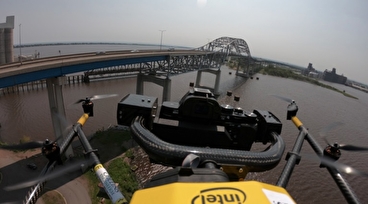
Sensing the Future of Infrastructure

Lauren Linderman, Associate Professor, Civil, Environmental, and Geo- Engineering
Area of Expertise: Bridge Engineering
Our nation’s infrastructure suffers from the perennial challenge of how to leverage limited resources to effectively maintain roadways, bridges, and lifelines. These systems are typically designed for a 50- to 100-year lifespan and are often used significantly longer. Increased demand from larger vehicles, greater traffic volume, and climate change will only put a greater strain on our infrastructure.
Regular inspection and maintenance is critical both for everyday performance and for informing longer-term decisions about whether to rehabilitate or replace older structures. The Fern Hollow Bridge collapse in Pittsburgh highlights how routine inspection—which identifies deficiencies—needs to be accompanied by performance tracking and maintenance prioritization in order to avoid catastrophic failures. With infrastructure sensor technology proliferating and becoming more affordable, we can better track the performance of key structures and provide stakeholders with decision-making support in the future. Instrumenting infrastructure not only provides vital data to assess the ongoing performance of existing structures but can also inform choices about future projects, making them more durable and effective.
While the push for structural health monitoring systems is not new, the improvement in sensing technologies, deployment strategies, and data analysis techniques means this is no longer a “what-if” but a viable strategy.

Including sensing technology and performance tracking plans in the design stage allows key quantities to be measured and knowledge of design limit states to be incorporated. The I-35W St. Anthony Falls Bridge in Minneapolis is fitted with more than 500 sensors selected to monitor structural changes over time and confirm design assumptions. The foresight to implement this system during construction allowed for temperature and strain measurements to be gathered from sensors embedded inside the concrete superstructure. The temperature loads and concrete response are essential for characterizing the long-term serviceability of the bridge and for providing unique insight on the environmental loads on these structures. These loads often dominate as compared to traditionally measured auto traffic. The sensors installed in the bridge do far more than inform agencies about its condition; they also provide insights into how issues such as temperature gradients and creep behavior should influence future designs in the region.
While the push for structural health monitoring systems is not new, the improvement in sensing technologies, deployment strategies, and data analysis techniques means this is no longer a “what-if” but a viable strategy. Numerous DOTs utilize uncrewed aerial vehicles for regular “visual” inspection of bridge structures, simplifying inspection of structures over rivers and access to hard-to-reach areas. Computer vision algorithms allow these videos to be analyzed for signs of distress and comparison among repeated inspections. Smartphones equipped with onboard sensing, such as accelerometers, allow for routine drives along these networks to be used for system characterization. The application of these tools from the computer science and aerospace fields already enables improved analysis of existing structures.
Combining embedded sensors with surface-level observations will provide a more complete picture of infrastructure performance. The advent of low-power, low-cost embedded wireless technologies will allow for dense deployments of these sensors to capture loads and behavior over time. These emerging technologies will supplement visual inspection and traditional load-rating techniques. However, synthesizing this data to identify potential structural distress is not straightforward, as each bridge, tunnel, and road design is unique and subjected to very local load demands. The question becomes how we leverage and augment these tools to effectively prioritize maintenance and replacement of these systems.